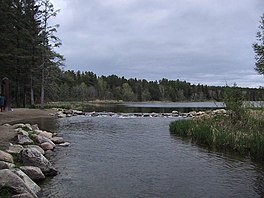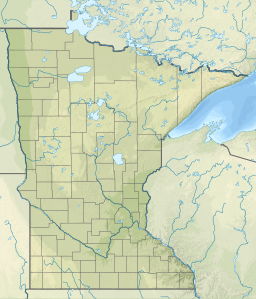geo.wikisort.org - Reservoir
Lake Itasca is a small glacial lake, approximately 1.8 square miles (4.7 km2; 1,200 acres) in area. Located in southeastern Clearwater County, in the Headwaters area of north central Minnesota, it is notable for being the headwater of the Mississippi River. The lake is in Itasca State Park. It has an average depth of 20 to 35 feet (6.1 to 10.7 m) and is 1,475 feet (450 m) above sea level.
| Lake Itasca | |
|---|---|
 The primary source of the Mississippi River on the edge of Lake Itasca | |
 Lake Itasca  Lake Itasca | |
| Location | Itasca State Park, Clearwater County, Minnesota, US |
| Coordinates | 47°13′05″N 95°12′26″W |
| Type | Glacial |
| Native name | Omashkoozo-zaaga'igan (Ojibwe) |
| Primary inflows | Nicolet Creek, Elk Lake outlet stream |
| Primary outflows | Mississippi River |
| Basin countries | United States |
| Surface area | 1.8 sq mi (4.7 km2) |
| Average depth | 20–35 ft (6–11 m) |
| Surface elevation | 1,475 ft (450 m) |
| Islands | Schoolcraft Island |
The Ojibwe name for "Lake Itasca" is Omashkoozo-zaaga'igan (Elk Lake);[1] this was changed by Henry Schoolcraft to "Itasca", coined from a combination of the Latin words veritas caput ("true head [of the Mississippi]").[2][3] It is one of several examples of pseudo-Indian place names created by Schoolcraft.
Source of the Mississippi River
It is the primary source[lower-alpha 1] of the Mississippi River which flows 2,340 mi (3,770 km) to the Gulf of Mexico. There are several tributaries that flow (most or all of the year) into the lake, one of which, by most modern definitions, as with the Nile River and Amazon River, would be considered the actual source, though less dramatic than the lake's outflow. Henry Schoolcraft identified Lake Itasca as the river's primary source in 1832. He had been part of a previous expedition in 1820 led by General Lewis Cass that had named nearby Cass Lake (which is downstream from Itasca) as the source of the river. There exists a dissenting claim that fur trader William Morrison was the first person to discover the lake and identified it as the source of the Mississippi in 1804.[6]
The western arm of the lake is fed by two streams on its south end. Nicollet Creek starts in a nearby spring. Another small stream leads into Itasca from Elk Lake,[lower-alpha 2] which in turn is fed by two other streams. The Ojibwa called Elk Lake and the stream Bekegamaag-zaaga'igan and Bekegamaag-ziibi (Sidelake Lake and Sidelake River), respectively.[1] In 1887 Williard Glazier promoted a campaign to consider Elk Lake, which he called Glazier Lake, as the true source of the Mississippi. Its longest tributary originates at Little Elk Lake, which is 100 ft (30 m) higher in elevation and 11 km upstream from the Lake Itasca outflow, at 47.158°N 95.224°W and in the Mississippi watershed.
Jacob V. Brower, a land surveyor and president of the Minnesota Historical Society, after spending five months exploring the lakes, claimed that the lakes and streams further south of Lake Itasca were not the true source of the Mississippi because they were "too small". Modern explorers and geographers, however, have used the tiniest trickles of water to determine the source of the Amazon, Nile, and other rivers. Brower was to campaign aggressively to save the lake from logging. On April 21, 1891, the Minnesota Legislature officially made it a state park by a margin of one vote. Brower is now called the "Father of Lake Itasca" and the visitor center is named in his honor.


The channel of the Mississippi as it emerges from the lake was bulldozed in the 1930s by the Civilian Conservation Corps, to create a more "pleasant experience" for visitors. The project included the draining of the surrounding swamp, the digging of a new channel, and the installation of a man-made rock rapids. The rocks are used by tourists for walking across the Mississippi River.[7][8]
Common ground for science

The lake is home to the University of Minnesota's Itasca Biological Station and Laboratories campus, which offers spring and summer courses and field research work year-round. The campus was established in 1909.[9] Some of these buildings date from the 1930s and 40s, while others, including the largest building the Biome Center, were built more recently. The current Director of the biological station is Jonathan Schilling.
The Lake Itasca region claims a unique location, not only at the headwaters of the Mississippi River and amidst 25% of the old growth forest of Minnesota, but also at the juncture of the three great habitats of North America: the Great Plains, the Deciduous Forest of the south, and the Coniferous Forest of the north. Remnants of all three may be observed in the park.
The unique geography of the Lake Itasca region has found its way onto the classical music concert stage. Composer Ferde Grofe depicted the birthplace of the Mississippi River and the Native Americans who reside there in his popular classical epic the Mississippi Suite.
See also
- List of Minnesota lakes
- USRC Itasca (1907)
- USCGC Itasca (1929)
Notes
- The United States Geological Survey recognizes two contrasting definitions of a river's source.[4] By the stricter definition, the Mississippi would share its source with its longest tributary, the Missouri, at Brower's Spring in Montana. The other definition acknowledges "somewhat arbitrary decisions" and places the Mississippi's sources at Lake Itasca, which is publicly accepted as the source of the Mississippi,[4] identified as such by a late 1800s surveyor Brower.[5]
- See the article on Julius Chambers on the discovery of Elk Lake.
References
- Gilfillan, Joseph A. (1887). "Minnesota Geographical Names Derived from the Chippewa Language". The Geological and Natural History Survey of Minnesota: The Fifteenth Annual Report for the Year 1886. St. Paul: Pioneer Press Company.
- Bright, William (2004). Native American Placenames of the United States. Norman: University of Oklahoma Press. p. 188.
- Upham, Warren. "Itasca County". Minnesota Place Names: A Geographical Encyclopedia. Minnesota Historical Society. Archived from the original on January 8, 2011. Retrieved August 14, 2007.
- Kammerer, J.C. (May 1990). "Largest Rivers in the United States". United States Geological Survey.
- Nell, Donald F.; Demetriades, Anthony (July–August 2005). "The True Utmost Reaches of the Missouri: Were Lewis and Clark Wrong When They Identified the Source of This Great River?". Montana Outdoors.
- Morrison, William (1872). Who discovered Itasca Lake? : letter of Wm. Morrison, an early Indian trader. St. Paul: Minnesota Historical Society. Retrieved February 6, 2021 – via Library of Congress.
- "A Trip North to the Mississippi Headwaters". Explore Minnesota. Archived from the original on October 17, 2020.
You can walk across the headwaters, by bridge or on stones
- Archived at Ghostarchive and the Wayback Machine: Mississippi Headwaters; Itasca State Park MN. Prairie Public Television. February 20, 2013.
you can walk on the rocks and over the shallow stream that actually is the headwaters of the great Mississippi River.
- Itasca Biological Station and Laboratories, College of Biological Sciences (February 20, 2015). "About Itasca". University of Minnesota. Retrieved November 25, 2020.
External links
На других языках
[de] Lake Itasca
Der Lake Itasca ist ein Gletscherrandsee im Nordwesten von Minnesota, USA. Er hat eine Größe von rund 4,7 Quadratkilometern und ist Quellsee des Mississippi. Lake Itasca liegt im Südwesten vom Clearwater County im Itasca State Park.- [en] Lake Itasca
[es] Lago Itasca
El lago Itasca (en inglés: Lake Itasca) es un pequeño lago glacial de los Estados Unidos, de aproximadamente 4,7 km² de superficie, localizado en el noroeste del estado de Minnesota y que es considerado oficialmente como el lugar de nacimiento del río Misisipi. El lago está localizado al sureste del condado de Clearwater, en el interior del Itasca State Park. Tiene una profundidad media de entre 6 y 11 m y está situado a 450 m sobre el nivel del mar.[fr] Lac Itasca
Le lac Itasca est un petit lac glaciaire formé après le recul de l'inlandsis, à la fin de la glaciation wisconsinienne. Il a une superficie d'environ 4,7 km2, et se situe dans la région de Headwaters au centre-nord de l'État du Minnesota. Il est connu pour être la source du fleuve Mississippi.[it] Lago Itasca
lago Itasca è un lago degli Stati Uniti d'America localizzato nello Stato del Minnesota settentrionale. È un lago di origine glaciale, formata dopo il ritiro dei ghiacci alla fine della glaciazione del Wisconsin. È noto per essere la fonte del fiume Mississippi. Copre una superficie di 4,7 km² e si trova a 450 metri sopra il livello del mare. La sua profondità varia dai 6 agli 11 metri. Il lago è ritenuto la sorgente occidentale del Mississippi. Al patriota e geografo italiano Giacomo Costantino Beltrami viene attribuita la scoperta della sorgente settentrionale che raggiunse nel 1823, a cui diede il nome di Lago Giulia in onore della nobildonna Giulia de Medici.[ru] Айтаска (озеро)
Айтаска, также встречается написание Итаска[1] (англ. Lake Itasca) — небольшое ледниковое озеро в США. Расположено в округе Клируотер на северо-западе штата Миннесота, на территории парка штата Айтаска. Имеет площадь 4,4 км² и глубину 12 метров, находится на высоте 450 м над уровнем моря[2].Другой контент может иметь иную лицензию. Перед использованием материалов сайта WikiSort.org внимательно изучите правила лицензирования конкретных элементов наполнения сайта.
WikiSort.org - проект по пересортировке и дополнению контента Википедии